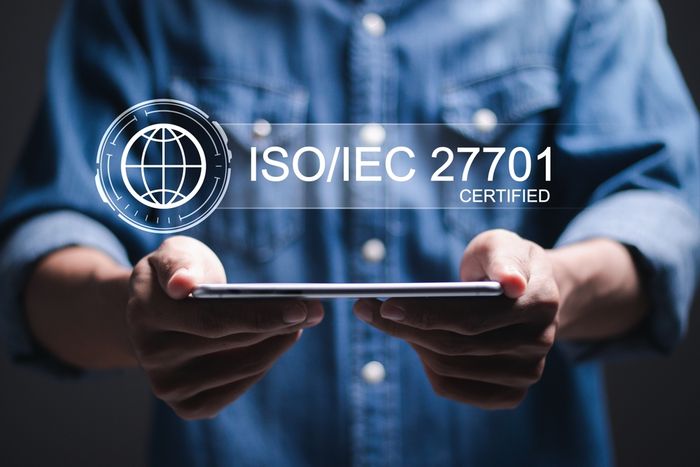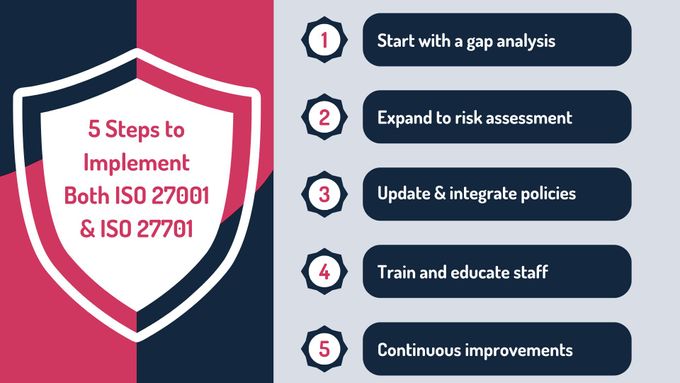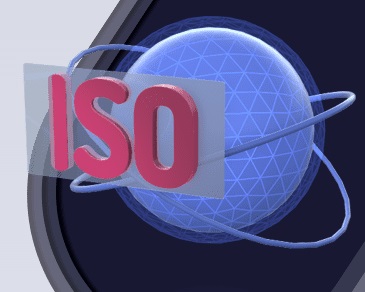How ISO 27001 and ISO 27701 Work Together: Future-Proof Data Privacy
Combining ISO 27001 and ISO 27701 strengthens your data security and privacy, ensuring compliance with global regulations while building trust with your stakeholders.
Published April 5, 2025.

As organizations rely more on digital platforms and global operations, protecting sensitive information is crucial for maintaining business integrity and building trust with customers and stakeholders. ISO 27001 is the cornerstone of information security, offering a framework for a robust information security management system (ISMS) that safeguards critical data.
With growing privacy concerns and stricter data protection regulations, ISO 27701 focuses on managing personally identifiable information (PII). Together, these standards offer an integrated approach to managing security and privacy risks, ensuring comprehensive protection and reinforcing your commitment to data privacy and compliance laws.
» Need help with ISO implementation? Contact GRSee for fast assistance
ISO 27001: Establishing the Security Baseline
ISO 27001 is an internationally recognized standard designed to manage information security through a systematic approach. It provides a comprehensive framework for establishing, implementing, maintaining, and continuously improving your information security management system (ISMS).
ISO 27001 focuses on risk management—protecting the confidentiality, integrity, and availability of information. It helps identify security risks, implement controls, and continuously monitor and improve security measures. By establishing this baseline, ISO 27001 safeguards against threats, from cyberattacks to internal breaches, ensuring your information assets stay secure and resilient.
While ISO 27001 effectively manages information security, it doesn’t specifically address the privacy of personally identifiable information (PII). This becomes crucial when dealing with regulations like the GDPR and CCPA, which require more than robust security.
» Confused? Understand the differences between GDPR, CCPA, and TXPPA
Explaining ISO 27701: Extending Security
ISO 27701 is an extension of ISO 27001, designed to enhance your ISMS by incorporating privacy management practices. It provides a framework for managing PII, effectively transforming your ISMS into a privacy information management system (PIMS).
ISO 27701 aligns with global privacy laws, helping you manage personal data privacy more effectively.
With privacy-specific controls, ISO 27701 adds an essential layer to your ISMS, embedding privacy into every aspect of information security. This makes ISO 27701 a crucial addition to your security strategy, especially in today’s privacy-conscious world.
» Discover what good compliance is and how to get started
ISO 27701 Control Differences
PII inventory and data mapping
Maintaining a comprehensive inventory of PII is essential for understanding what data you collect, where it is stored, and how it is processed. ISO 27701 mandates you to maintain an accurate inventory and perform data mapping to identify all PII within your systems.
This step ensures that data is accounted for and managed appropriately throughout its lifecycle.
Data minimization
ISO 27701 emphasizes the principle of data minimization, which requires you to collect only the minimum amount of PII necessary for your operations. This reduces the risk of data breaches by limiting the amount of sensitive information that needs to be protected.
By adhering to this principle, you can minimize exposure to privacy risks and avoid holding unnecessary data.
Privacy by design
This involves integrating privacy considerations into every stage of product development and business processes. ISO 27701 requires you to embed privacy into the design of your systems and processes, ensuring that privacy protections are foundational.
This proactive approach helps prevent privacy issues and ensures that PII is handled in compliance with relevant regulations from the outset.
Third-party management
Managing third-party relationships is critical for maintaining privacy standards, as third parties often have access to PII. ISO 27701 stresses the importance of ensuring that third-party vendors comply with the same privacy standards as you.
This involves conducting due diligence, establishing clear privacy requirements in contracts, and regularly monitoring third-party compliance to mitigate the risk of privacy breaches.
Incident management
ISO 27701 specifies requirements for managing incidents involving PII, including the development of an incident response plan for privacy breaches. You must be ready to respond quickly and effectively to any incident that compromises PII, including notifying affected individuals and regulators as required by law.
Effective incident management minimizes breach impacts and ensures swift recovery while maintaining compliance with privacy regulations.
» Find out how ISO 27001 acts a springboard to CCPA compliance
Benefits of Combining ISO 27701 with ISO 27001
1. Holistic Data Protection
Combining ISO 27701 with ISO 27001 provides comprehensive protection for both information assets and personally identifiable information (PII). This dual focus ensures data is secure from breaches and managed in a way that respects privacy rights.
2. Regulatory Compliance
ISO 27701 helps you adhere to international privacy laws such as GDPR and CCPA. By embedding privacy controls within the ISMS framework, you can more easily meet regulatory requirements, reducing the risk of non-compliance and associated legal penalties.
3. Building Trust
Certifying in both ISO 27001 and ISO 27701 enhances confidence among your clients and partners by demonstrating a strong commitment to privacy and security. Certified privacy practices highlight your dedication to protecting personal data, which can be a significant differentiator in competitive markets.
4. Operational Synergy
Aligning security and privacy controls through ISO 27701 and ISO 27001 improves operational efficiency by reducing duplication of efforts. Streamlining processes ensures that security and privacy measures are coordinated and complementary, enhancing the effectiveness of data protection and simplifying management and audits, saving you time and resources.
» Incorporate secure development for agile workflow
5. Strategic Advantage
Dual certification in ISO 27001 and ISO 27701 offers you a strategic advantage in privacy-conscious markets. As data privacy becomes increasingly important to consumers and partners, these certifications can set you apart from competitors, leading to new business opportunities and reinforcing your position as a leader in data protection.
ISO 27001 and ISO 27701 offer a unified framework for managing security and privacy risks. ISO 27001 establishes a robust ISMS, while ISO 27701 integrates privacy management for PII, ensuring compliance with global privacy regulations. This combined approach addresses a broader range of risks, enhances governance, and demonstrates a commitment to data protection.
» Show investors your dedication to safety: Become ISO 27001 compliant
Scenarios for Dual Framework Use
1. Healthcare Providers
As a healthcare provider storing sensitive patient data, you might be at risk for various healthcare-specific cybersecurity risks. Integrating ISO 27001 and ISO 27701 benefits you:
- ISO 27001 establishes an ISMS to protect the confidentiality, integrity, and availability of patient data, essential for defending against cyber threats and maintaining critical systems.
- ISO 27701 enhances privacy management, ensuring compliance with regulations like HIPAA and GDPR for Personally Identifiable Information (PII).
» See these top healthcare cybersecurity trends
2. E-Commerce Companies
As an e-commerce company handling substantial customer data, including payment information, you benefit from both ISO 27001 and ISO 27701:
- ISO 27001 provides a framework for securing transactions and preventing data breaches
- ISO 27701 ensures customer PII is managed in line with global privacy regulations.
This commitment to data protection becomes a key differentiator in a competitive market, attracting customers and stakeholders who value privacy and security.
Practical Steps for Successful Implementation
- Start with a gap analysis: Conduct a thorough gap analysis to identify discrepancies between your current security and privacy controls and the requirements of ISO 27001 and ISO 27701. This defines the scope of work, helping you prioritize actions to achieve compliance with both standards.
- Expand to risk assessment: Understand what's involved in the risk assessment process to include privacy risks specific to PII. Evaluate how these risks align with privacy regulations and identify potential data breaches, helping you develop a comprehensive mitigation plan.
- Update and integrate policies: Develop and integrate policies that reflect both the ISMS and PIMS requirements. Ensure policies align with standards and meet operational needs, creating a cohesive framework where security and privacy practices work together.
- Train and educate staff: Develop a training program to ensure all employees understand their roles in maintaining compliance with ISO 27001 and ISO 27701. Regular updates and training sessions will reinforce these practices and keep everyone informed about new developments.
- Foster continuous improvement: Regularly review and update your ISMS and PIMS to ensure they remain effective and compliant with evolving standards. Embed continuous improvement into your organization’s culture to drive proactive enhancements in security and privacy practices.
» Here are 6 things you should know before hiring a risk assessment service provider
Example Organizations That Adopted Both Standards
Microsoft
Microsoft has implemented ISO 27701 across its cloud services, including Azure and Office 365, assuring global customers that their data is managed with top-tier security and privacy standards. Building on its ISO 27001 certification, Microsoft demonstrates compliance with global privacy regulations like GDPR, enhancing customer trust and mitigating legal risks.
Alibaba Cloud
Alibaba Cloud added ISO 27701 to its ISO 27001 certification, strengthening its data protection framework. This integration allows Alibaba Cloud to address global privacy requirements, including GDPR and China’s Cybersecurity Law, ensuring robust privacy and security for its customers.
Why Choose GRSee for ISO 27001 and ISO 27701?
GRSee Consulting offers an integrated approach to implementing ISO 27001 and ISO 27701, ensuring effective management of both security and privacy. We begin with a thorough gap analysis, forming a detailed plan to achieve full certification. Our extended risk assessment covers PII risks, including data breaches, compliance, and incident response.
We help develop mitigation plans, update policies, implement privacy controls, and provide staff training. GRSee supports ongoing monitoring, incident response, and internal audits, ensuring you confidently achieve and maintain ISO compliance while safeguarding your data and enhancing your market position.
» Ready to begin? Contact us to start your ISO compliance process







